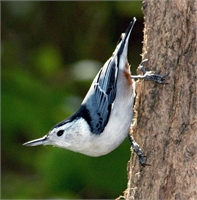
Photo by Howard Eskin
Audobon Arkansas/Arkansas
Game and Fish
I never actually sought out birds until about two-and-a-half years ago. To that point, I saw only the predictable variety of cardinals, blue jays, sparrows and the occassional woodpecker. But while shopping for a house in October 2008, standing on the back deck of a beautiful, nature-wrapped home in Kanis Village, I spied something new: a round little black and gray bird with a long beak and a white belly, hopping head-first down the trunk of a white oak tree.
The bird looked up in my direction from his topsy-turvy perch and said, "Uh-uh." "Uh-uh." And that's how I met the white-breasted nuthatch. I called my wife and said, "I'm standing on the deck of my new home." If the view out the back window and the surrounding woods weren't enough, that gregarious bird had sealed the deal for me. Upon first introduction, the bird would get within 10 feet of me without flinching. I still see a family of nuthatches in my yard today, and they have become my favorite bird for their friendly attitude and loud nasal call.
The most charming thing about this bird is his habit of "hatching" nuts. The nuthatch primarily eats insects that he finds in the bark of trees, but will also eat small nuts and acorns, wedging those nuts into a fissure in the tree and concealing them with a bit of moss, lichen or snow. Later, the nuthatch will come back and hammer the seed with his powerful beak, "hatching" the nut from its shell.
You usually find the white-breasted nuthatch in mature deciduous (trees that drop their leaves) forests, and mostly at the edge of the woods. That's the exact habitat we provide here at lovely Kanis Village, as the neighborhood is encircled by woods.
It's fun to watch the bird move at crazy angles to the trunk, hopping along upside-down, then craining its neck upward to look around for predators. Whenever you see the white-breasted nuthatch foraging for food, you typically see his constant companions, the Carolina chickadee, tufted titmouse and various woodpeckers. These birds have developed the culture of foraging together for mutual protection. By personality, they do not interfere with each other much, though the white-breasted nuthatch does protect its territory from others of its species.
For a really nice site about the white-breasted nuthatch, check out the Cornell ornithology lab's page at http://www.allaboutbirds.org/guide/White-breasted_Nuthatch/id
Here you can hear the the bird's loud, nasal call and find a lot more info. The "uh-uh" thing is something they do while hopping around feeding. Terribly cute. If you see one in your back yard, just sit out on your deck and watch it for a spell. You will be completely charmed.
No comments:
Post a Comment